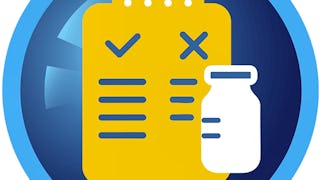Welcome to the Evidence-based Toxicology (EBT) course. In medicine and healthcare, evidence-based medicine has revolutionized the way that information is evaluated transparently and objectively. Over the past ten years, a movement in North America and Europe has attempted to translate this revolution to the field of toxicology.

Gain next-level skills with Coursera Plus for $199 (regularly $399). Save now.

(121 reviews)
Skills you'll gain
Details to know

Add to your LinkedIn profile
9 assignments
See how employees at top companies are mastering in-demand skills

There are 7 modules in this course
This module introduces you to the course, outlines the shortcomings of current toxicity testing approaches, and shows how EBT can help to overcome these shortcomings.
What's included
9 videos3 readings1 assignment1 discussion prompt
This module explains how evidence-based toxicology originated and describes the driving forces for the initiative. In the second lesson, you will learn how to distinguish between correlation and causation as well as the main problems with drawing conclusions on the basis of correlations. The Bradford Hill criteria are introduced, along with examples for each criterion. You will also learn about mechanistic toxicology and mechanistic validation.
What's included
11 videos2 readings1 assignment1 discussion prompt
This module shows how to perform systematic reviews and meta-analyses. You will learn the history of both methods and will receive step-by-step instructions on how to perform systematic reviews and meta-analyses using examples from the research activities of the instructors.
What's included
8 videos2 readings2 assignments1 discussion prompt
This module teaches you about possible biases that can be introduced at different stages of research. Each bias is explained with examples, including solutions for overcoming those biases. The second lesson covers systematic review of the zebrafish embryotoxicity test as a case study conducted by the Evidence-based Toxicology Collaboration (EBTC). You will go through all of the steps of the systematic review again to imprint the knowledge from module 3, but this systematic review will be related to a toxicological method.
What's included
8 videos2 readings1 assignment1 discussion prompt
Quality control is a very important aspect of not only modern toxicology but the entirety of life sciences. The first lesson in this module demonstrates the importance of performing quality control on your experiments. The second lesson is connected with the first one because validation of an alternative method requires highly standardized protocols and quality control at each step. This lesson teaches you different aspects of alternatives methods validation, how to perform classical validation, its pitfalls, and strategies to overcome them.
What's included
10 videos2 readings1 assignment1 discussion prompt
Evidence-based toxicology requires some knowledge of bioinformatics. The first lesson in the module teaches you some biostatistical tools you can apply when analyzing predectivity, specificity, and sensitivity of a method. You will also learn how to identify biases in a study with the help of bioinformatics. Evidence-based principles can be applied to every question you might have, even to which pizza to order tonight. You will learn the difference between eminence-based vs. evidence-based approaches. You will learn what is driving the lack of reproducibility and how evidence-based approaches should help to overcome the reproducibility crisis in science, which is explained with examples of experimental design, wrong models, poor quality of the cell cultures, etc.
What's included
8 videos1 reading2 assignments1 discussion prompt
The final week of the course is devoted to completing the Systematic Review Assignment. You will use SysRev to review at least 20 abstracts, apply inclusion and exclusion criteria, render decisions, and resolve conflicts with other reviewers.
What's included
1 reading1 assignment1 plugin
Instructors


Offered by
Explore more from Basic Science
 Status: Preview
Status: PreviewJohns Hopkins University
 Status: Free Trial
Status: Free TrialJohns Hopkins University
 Status: Free Trial
Status: Free TrialNovartis
 Status: Free Trial
Status: Free TrialJohns Hopkins University
Why people choose Coursera for their career




Learner reviews
121 reviews
- 5 stars
76.85%
- 4 stars
17.35%
- 3 stars
4.95%
- 2 stars
0.82%
- 1 star
0%
Showing 3 of 121
Reviewed on Jul 4, 2020
Quite informative and exposed me to a whole new horizon in the ever blooming world of toxicology. I would like to thank Dr. Thomas Hartung and his team at John Hopkins for making this possible!
Reviewed on Jul 31, 2021
Excellent, it has given me a very clear and complete vision.gave me a very clear and complete picture.
Reviewed on Jun 11, 2020
The course was very well thought out and very informative

Open new doors with Coursera Plus
Unlimited access to 10,000+ world-class courses, hands-on projects, and job-ready certificate programs - all included in your subscription
Advance your career with an online degree
Earn a degree from world-class universities - 100% online
Join over 3,400 global companies that choose Coursera for Business
Upskill your employees to excel in the digital economy
Frequently asked questions
To access the course materials, assignments and to earn a Certificate, you will need to purchase the Certificate experience when you enroll in a course. You can try a Free Trial instead, or apply for Financial Aid. The course may offer 'Full Course, No Certificate' instead. This option lets you see all course materials, submit required assessments, and get a final grade. This also means that you will not be able to purchase a Certificate experience.
When you purchase a Certificate you get access to all course materials, including graded assignments. Upon completing the course, your electronic Certificate will be added to your Accomplishments page - from there, you can print your Certificate or add it to your LinkedIn profile.
Yes. In select learning programs, you can apply for financial aid or a scholarship if you can’t afford the enrollment fee. If fin aid or scholarship is available for your learning program selection, you’ll find a link to apply on the description page.
More questions
Financial aid available,

